University of Putra Malaysia (UPM), also known as Universiti Putra Malaysia, known for its strong focus on agricultural science and diverse academic offerings. Founded in 1931 as the School of Agriculture, UPM has grown into a leading institution, playing a key role in Malaysia’s education sector and advancing research across multiple disciplines.
Largest University in Malaysia
UPM is Located in Serdang, began with small roots, offering only a one year certificate in agriculture. Today, it stands as the largest university in Malaysia, attracting students from around the world who seek top-notch education in agriculture, science, and more.
In 1971, the Serdang College of Agriculture merged with the University of Malaya’s Faculty of Agriculture to form University of Pertanian Malaysia. Dr. Mohd. Rashdan bin Haji Baba, the then-principal of the College of Agriculture Malaya, was appointed as the first Vice-Chancellor under the Universities and University Colleges Act of 1971.
Throughout the 1990s, UPM expanded its academic offerings to include human ecology, languages, architecture, medicine, computer science, and biotechnology. Today, the university encompasses 16 faculties, 16 centers, nine institutes, one school, and one academy, covering fields such as agriculture, forestry, veterinary medicine, economics, engineering, sciences, and education.
UPM University History
The initial intake of University Pertanian Malaysia in July 1973 included the Faculty of Veterinary Medicine and Animal Sciences, Faculty of Forestry, Faculty of Agriculture, and a Division of Foundation Studies, totaling 1,559 students.
In the early 1980s, UPM expanded its scope to include science and technology. In 1997, the university was renamed University Putra Malaysia by former Prime Minister Tun Dr. Mahathir Mohammad, highlighting its evolution into a comprehensive institution offering diverse fields of study, particularly in science and information technology, to support national development.
Rankings of UPM:
According to the 2026 QS World University Rankings, UPM is ranked 134th globally, 22th among Asian universities, and is the Forth best university in Malaysia. Additionally, UPM is considered “Highly Competitive” in the Integrated Rating of Malaysian Institutions of Higher Education (SETARA).
For more details on the rankings of Malaysian universities, visit our updated guide on Malaysia University Rankings.
Vision, Mission, and Goals
Vision: To become a university of international repute.
Mission: To make meaningful contributions to the creation of prosperity and development of the nation and the well-being of all human beings through the exploration and dissemination of knowledge.
Goals:
- Produce resilient graduates who can withstand challenges.
- Establish research and innovation hubs that generate value-based sustainable ecosystems.
- Create a sustainable industry and community networking ecosystem.
- Strengthen agriculture and food security resilience.
- Enhance institutional governance, financial stability, and sustainable practices.
Information about University Putra Malaysia (UPM):
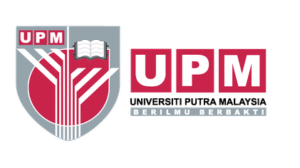 |
|
| Name | University Putra Malaysia |
| QS Global World Ranking | #134 |
| Asian Ranking | #22 |
| Motto | With Knowledge We Serve |
| University Type | Public |
| Total Students | 25,600+ |
| Academic Faculty Staff | 3,370 |
| Research Output | Very High |
| Established | 21 May 1931 |
| Location | Serdang, Selangor, Malaysia |
| Website | www.upm.my |
Faculties and Institutes
- Faculty of Agriculture
- Faculty of Forestry
- Faculty of Veterinary Medicine
- Faculty of Economics and Management
- Faculty of Engineering
- Faculty of Educational Studies
- Faculty of Science
- Faculty of Food Science and Technology
- Faculty of Human Ecology
- Faculty of Modern Languages and Communication
- Faculty of Design and Architecture
- Faculty of Medicine and Health Sciences
- Faculty of Computer Science and Information Technology
- Faculty of Biotechnology and Biomolecular Sciences
- Faculty of Environmental Studies
- Faculty of Agriculture and Food Science (located at Bintulu, Sarawak)
- Institute of Bioscience
- Institute of Advanced Technology (ITMA)
- Institute of Gerontology
- Institute of Mathematical Research
- Halal Product Research Institute
- Institute of Tropical Forestry and Forest Product
- Institute of Agriculture and Food Policy Studies
- Institute for Social Science Studies
- Institute of UTropical Agriculture
University Putra Malaysia (UPM) on QS Ranking 2025
University Putra Malaysia (UPM), has achieved an impressive ranking in the 2025 QS World University Rankings. UPM was rated #148 globally and #25 in Asia, showcasing its strong academic reputation and quality of education.
Top Subjects at UPM
University Putra Malaysia (UPM) excels in various academic fields, with notable achievements in the QS World University Rankings by Subject 2022. UPM was ranked first in Malaysia for two subjects: Veterinary Science and Agriculture and Forestry. This accomplishment highlights UPM’s dedication to excellence in these areas, as stated by the university’s vice chancellor, Professor Datuk Dr. Mohd Roslan Sulaiman.
Minimum English Language Requirements at UPM
To gain admission to UPM, students must meet the minimum English language proficiency requirements, except for the Doctor of Medicine and a few Bachelor programs which have higher requirements. Here are the acceptable scores:
- IELTS band 5.5 and above; or
- TOEFL iBT score of 60 and above; or
- CIEP level 107 and above; or
- PTE Score of 43 and above; or
- Cambridge English (CAE/CPE/Linguaskill) Score 154 and above
Facilities and Services at University Putra Malaysia (UPM)
As a leading academic institution with international recognition, University Putra Malaysia (UPM) offers outstanding facilities and services to meet the diverse needs of its campus community. UPM’s commitment to excellence ensures that students, faculty, and staff have access to world-class resources and support.
Accommodation
On-Campus Housing at University Putra Malaysia (UPM)
University Putra Malaysia (UPM) offers 17 well-equipped residential colleges to ensure a comfortable and convenient stay for its students. These colleges feature modern computer and study areas, laundry services, and other essential amenities to support student life.
UPM also provides excellent housing options for graduate students, including contemporary flats at the Graduate Housing Complex, designed specifically for married international and local students. International students are encouraged to book their accommodation before arriving in Malaysia to secure their spot.
The Graduate Housing Complex is strategically located on campus, giving students easy access to university facilities and resources. This prime location fosters a supportive environment, enabling students to focus on their intellectual and personal development.
Off-Campus Housing Near UPM
For students seeking alternative accommodations, private housing is available near UPM. Some recommended areas for relocation include:
- Serdang Indah (4 km)
- Taman University (6 km)
- Taman Sri Serdang (2 km)
- Bukit Serdang (5 km)
- Serdang Jaya (2 km)
- Seri Kembangan/Serdang Baru (3 km)
- Balakong (4 km)
- Sungai Besi (6 km)
UPM University Library
The Sultan Abdul Samad Library at UPM is one of the best in the area and offers a wide variety of reading materials. A qualified group of library liaison officers supports this cutting-edge array of services.
Sport
The UPM sports complex has top-notch amenities like a stadium, a pool that meets international standards, soccer and rugby fields, as well as basketball, tennis, and badminton courts.
Student Health Center
International Partners Collaborations
University Putra Malaysia (UPM) is one of the leading Research Universities. UPM was founded in 1971 through a merger between the College of Agriculture Malaya and the Faculty of Agriculture, University of Malaya. Since its inception, UPM has continued to expand with a vision to become a university of international repute.
Research and Innovation
Research Institutes
UPM is home to several research institutes that drive its research agenda, fostering collaboration between academia, industry, and government. Notable institutes include:
Institute of Bioscience (IBS): Leading in biotechnological research, IBS focuses on areas such as genomics, bioinformatics, and agricultural biotechnology.
Institute of Tropical Agriculture and Food Security (ITAFoS): This institute addresses critical issues related to tropical agriculture, food production, and food security.
Malaysian Research Institute on Ageing (MyAgeing): Dedicated to ageing research, MyAgeing explores the biological, psychological, and social aspects of ageing, aiming to improve the quality of life for the elderly.
Research Achievements
UPM’s research contributions are vast and varied, spanning multiple disciplines. The university is particularly noted for its work in sustainable agriculture, biotechnology, and environmental conservation. UPM researchers have developed innovative agricultural practices, advanced medical treatments, and sustainable technologies that have had a significant impact both locally and globally.
Industry Collaboration
UPM maintains strong ties with industry partners, facilitating the transfer of knowledge and technology from academia to the marketplace. Collaborative projects with multinational corporations and local enterprises enhance the practical applications of UPM’s research, driving economic growth and societal benefits.
Global Partnership
UPM’s partnerships with governmental agencies and other bodies in the region are numerous and highly valued.
Close working relationship with the Department of Agriculture of Malaysia is particularly notable and has contributed to much research-led policy making. Such links, with governments, their agencies, and related bodies extend worldwide and include work with the United Nations, the World Health Organization, as well as with international private corporations.
UPM has numerous linkages and collaborations with outstanding international institutions and agencies around the globe such as the USA, Latin American countries, Japan, Korea, the Middle East, and others through Memorandum of Understanding and Memorandum of Agreement.
Various networking activities have been conducted such as mobility programs, staff and student exchange, research collaborations, commercialized activities, and technology transfer.
| University | Location |
Australia |
|
| University of Southern Queensland | Australia |
| University of Wollongong | Australia |
| University of Newcastle | Australia |
| Macquarie University, Sydney | Australia |
| The University of Western Australia | Australia |
Austria |
|
| University of Natural Resources and Life Sciences, Vienna | Austria |
Bangladesh |
|
| Bangladesh Agricultural University | Bangladesh |
| Cambodia | |
| University of Cambodia | Cambodia |
Canada |
|
| The University of Alberta | Canada |
China |
|
| Chengde Medical University | China |
| Jinan University | China |
| Hainan University | China |
| The Environment and Plant Protection Institute, Chinese Academy of Tropical Agricultural Sciences | China |
| Institute of Bast Fiber Crops, Chinese Academy of Agricultural Sciences (IBFC) | China |
| Fujian Agriculture and Forestry University | China |
| South China Agricultural University | China |
| Institute of Medicinal Plant Development (IMPLAD) | China |
| Guilin University of Electronic Technology China | China |
| Hunan University | China |
| WFCC-MIRCEN World Data Center for Microorganisms (WDCM) | China |
Denmark |
|
| Department of Geosciences and Natural Resource Management, University Of Copenhagen | Denmark |
Finland |
|
| Turku University of Applied Sciences | Finland |
| Asia Exchange Ltd. | Finland |
France |
|
| Ecole d’ingénieurs de PURPAN | France |
| Agropolis International | France |
| University of La Rochelle | France |
Germany |
|
| Ostbayerische Technische Hochschule Regensburg | Germany |
| Helmholtz-Zentrum Fur Umweltforschung GmbH, UFZ | Germany |
| Universitat der Bundeswehr Munchen | Germany |
| School of Humanities, University of Mannheim | Germany |
India |
|
| Kalasalingam University | India |
Indonesia |
|
| Institut Teknologi Bandung | Indonesia |
| Universitas Islam Indonesia | Indonesia |
| Bina Nusantara University | Indonesia |
| Universitas Muhammadiyah Pontianak | Indonesia |
| Universitas Airlangga | Indonesia |
| Universitas Sebelas Maret | Indonesia |
| Universitas Brawijaya | Indonesia |
| State Islamic University Syarif Hidayutullah, Jakarta | Indonesia |
| Sekolah Tinggi Ilmu Pertanian Agrobisnis Perkebunan (STIPAP) | Indonesia |
| University of Mulawarman (UNMUL) | Indonesia |
| University of Mataram (UNRAM) | Indonesia |
| Universitas Islam Negeri, Maulana Malik Ibrahim | Indonesia |
| Universitas Padjadjaran | Indonesia |
| Universitas Malahayati | Indonesia |
| Indonesian Institute of Sciences (LIPI) | Indonesia |
Iran |
|
| Sharif University of Technology | Iran |
| Alzahra University of Islamic Republic of Iran | Iran |
| University of Tehran | Iran |
| Ilam University of Medical Science | Iran |
| Isfahan University of Medical Sciences | Iran |
| Research Institute of Food Science and Technology (RIFST) | Iran |
| Materials and Energy Research Center (MERC) | Iran |
| Allameh Tabataba’I University | Iran |
| Islamic Azad University | Iran |
| Islamic World Science Citation Center (ISC) | Iran |
| University of Science and Culture | Iran |
| Tehran University of Medical Sciences | Iran |
| Amirkabir University of Technology | Iran |
Italy |
|
| International Plant Genetic Resources Institute | Italy |
| University of Padova | Italy |
| Politecnico Di Torino | Italy |
| Politecnico Di Milano | Italy |
Japan |
|
| Research Center of Supercritical Fluid Technology, Tohoko University | Japan |
| University of Tsukuba | Japan |
| Hiroshima University | Japan |
| Japan Advanced Institute of Science and Technology (JAIST) | Japan |
| Faculty and Graduate School of Engineering, Hokkaido University | Japan |
| Shibaura Institute of Technology | Japan |
| Atmosphere and Ocean Research Institute (The University of Tokyo) (AORI) | Japan |
| Kindai University | Japan |
| Shizuoka University | Japan |
| Kagoshima University | Japan |
| Chiba University | Japan |
| Shinshu University | Japan |
| Kanagawa University | Japan |
| Southern Tohoku Research Institute for Neuroscience | Japan |
| Niigata University | Japan |
| Nara Institute of Science and Technology (NAIST) | Japan |
| The Graduate School of Agriculture, Kyoto University | Japan |
| Okayama University | Japan |
| Functional Food Creation Research Institute Co.Ltd | Japan |
| Tokyo Metropolitan University | Japan |
| Tokyo University of Agriculture and Technology | Japan |
| Mitsubishi Corporation | Japan |
| Kyushu Institute of Technology | Japan |
| Kochi University | Japan |
| Graduate School of Horticulture and Faculty of Horticulture, Chiba University | Japan |
| The Forestry and Forest Products Research Institute (FFPRI) | Japan |
| Tokyo University of Agriculture (TUA) | Japan |
| The National Institute for Environmental Studies (NIES) | Japan |
| Soka University | Japan |
Kazakhstan |
|
| Suleyman Demirel University, The Republic of Kazakhstan | Kazakhstan |
| L.N Gumilyov Eurasian National University | Kazakhstan |
| M. Auezov South Kazakhstan State University Korea | Kazakhstan |
| Daejeon University | Kazakhstan |
| Chung-Ang University | Kazakhstan |
| Gwangju Institute of Science and Technology | Kazakhstan |
Kuwait |
|
| Kuwait Institute for Scientific Research | Kuwait |
Malta |
|
| The International Institute On Ageing, United Nations-Malta | Malta |
Mauritius |
|
| Alif Society | Mauritius |
Mexico |
|
| University of Guanajuato | Mexico |
Morocco |
|
| University of Guanajuato | Morocco |
New Zealand |
|
| The University of Otago, Dunedin | New Zealand |
Nigeria |
|
| University of Maiduguri | Nigeria |
Pakistan |
|
| University of Veterinary and Animal Sciences | Pakistan |
| Institute of Business Management (IoBM) | Pakistan |
| Sindh Agriculture University | Pakistan |
Palestine |
|
| University College of Applied Sciences | Palestine |
Philippines |
|
| The Southeast Asian Regional Center for Graduate Study and Research in Agriculture (SEARCA) | Philippines |
Portugal |
|
| University of Coimbra | Portugal |
Saudi Arabia |
|
| IBN Rushd College for Management Sciences, Abha | Saudi Arabia |
Spain |
|
| Universidad De Valladolid | Spain |
Sudan |
|
| Sudan University of Science and Technology | Sudan |
| National University Sudan | Sudan |
| Al Zaiem Al Azhari University | Sudan |
| National Ilan University | Sudan |
| National Pingtung University of Science and Technology | Sudan |
| National Cheng Kung University | Sudan |
| National Yunlin University of Science and Technology | Sudan |
Taiwan |
|
| National Taiwan University | Taiwan |
Thailand |
|
| Thailand Institute of Scientific and Technological Research (TISTR) | Thailand |
| Chiang Mai University | Thailand |
| Lampang Rajabhat University | Thailand |
| National Center For Genetic Engineering and Biotechnology, National Science and Technology Development Agency (BIOTEC) | Thailand |
| Chulalongkorn University | Thailand |
| Thonburi University | Thailand |
| Kasetsart University | Thailand |
| Thepsatri Rajabhat University | Thailand |
| Mahidol University | Thailand |
| Maejo University | Thailand |
| Srinakharinwirot University | Thailand |
| Silpakorn University | Thailand |
| Prince of Songkla University | Thailand |
| Naresuan University | Thailand |
Turkey |
|
| Ataturk University | Turkey |
| Istanbul Aydin University | Turkey |
| Mevlana Exchange Program Protocol | Turkey |
| Suleyman Demirel University | Turkey |
| Kirikkale Universitesi | Turkey |
| Cukurova University | Turkey |
| Izmir Katip University | Turkey |
| Sakarya university | Turkey |
| Erzurum Technical University | Turkey |
| Agri Ibrahim Cecen University | Turkey |
| Hitit University | Turkey |
| Ondokuz Mayis University | Turkey |
| Istanbul University | Turkey |
| Amasya University | Turkey |
| Ataturk University | Turkey |
UAE |
|
| United Arab Emirates University | United Arab Emirates |
United Kingdom |
|
| The University of Bristol | United Kingdom |
| The Chancellor Masters and Scholars of the University of Oxford | United Kingdom |
| Moredun Research Institute, Scotland | United Kingdom |
| University Reading | United Kingdom |
| Royal Agricultural University | United Kingdom |
| The University of Leeds | United Kingdom |
| The University of Sheffield | United Kingdom |
United States |
|
| Cornell University | United States |
| WSI Corporation | United States |
Republic of Uzbekistan |
|
| Tashkent State Agrarian University | Republic of Uzbekistan |
Vietnam |
|
| Nong Lam University | Vietnam |
| University of Social Sciences and Humanities, Vietnam National University | Vietnam |
| Hadhramout Establishment for Human Development | Yemen |
Multiple Institutions (Countries)
- Agropolis Fondation, France and Southeast Asian Regional Center For Graduate Study and Research in Agriculture (SEARCA), Philippines
- Asian Fisheries Society
- University Network For Tropical Agriculture (UNTA)
International Affiliations
UPM drives its direction towards becoming a global leading university with internationally accepted academic standards and global recognition through strategic collaborations with many global partners and active participation in global networks and international associations.
By participating in international associations, UPM offers enriching global education and research programs. Our academic faculties, research institutes, and centers are well-connected with other globally-oriented members of the associations which collaborate in various educational and research activities.
In addition, our students and staff have the opportunity to gain valuable cross-cultural experience and develop a strong appreciation of global issues and intercultural communications.
UPM is a member of many international associations around the world as listed below:
Africa
- Federation of the Universities of the Islamic World (FUIW)
America
- Commonwealth Association for Public Administration and Management (CAPAM)
- Association of University Technology Managers (AUTM)
Asia
- University Mobility in Asia and the Pacific (UMAP)
- Seameo Regional Center For Graduate Study and Research in Agriculture (SEARCA)
- Asian Association of Agricultural Colleges and Universities (AAACU)
- The Association of Southeast Asian Institutions of Higher Learning (ASAIHL)
- The Association of Universities of Asia and the Pacific (AUAP)
- Asia-Pacific Association Of Agricultural Research Institutions (APAARI)
ASEAN University Network (AUN)
Europe
- Association of Commonwealth Universities (ACU)
- Asean-European University Network (ASEA UNINET)
- International Association of Universities (IAU)
- International Council Of Museums (ICOM)
- EU-Malaysia Chamber of Commerce & Industry (EUMCCI)
- Committee on Sapace Research (COSPAR)
FAQs
Where is University Putra Malaysia located and when was it founded?
What programs were offered when University Putra Malaysia was first founded?
Who was appointed as the first Vice-Chancellor of University Pertanian Malaysia?
How many faculties, institutions, and schools are covered by University Putra Malaysia?
What is University Putra Malaysia's ranking?
What is University Putra Malaysia known for?
What facilities and services are provided by University Putra Malaysia?
Transportation Accessibility
UPM buses circulate the Serdang campus as they transport students to their destinations (e.g. residential colleges or academic zone).
The closest train station right now is in Serdang, KB05, which is 15 minutes’ drive from UPM. Despite the fact that e-hailing is available on campus, students can get there by taking the UPM or Smart Selangor buses (route SJ04).
 SharifStudy Best way to Study in Malaysia
SharifStudy Best way to Study in Malaysia

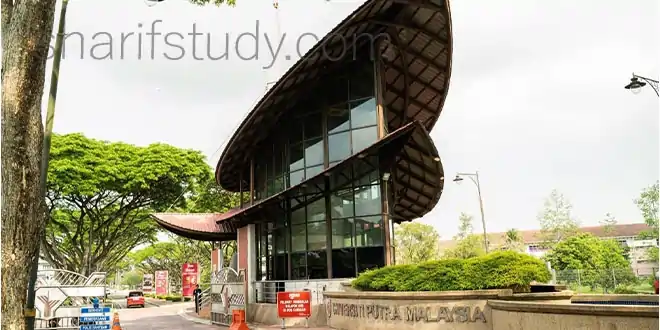


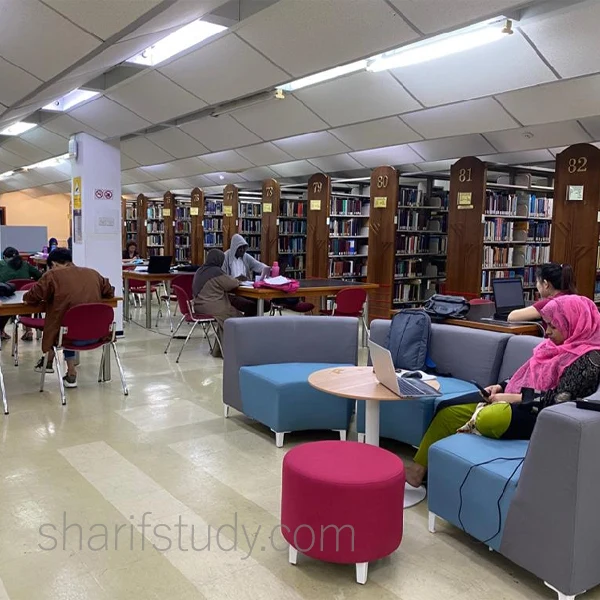
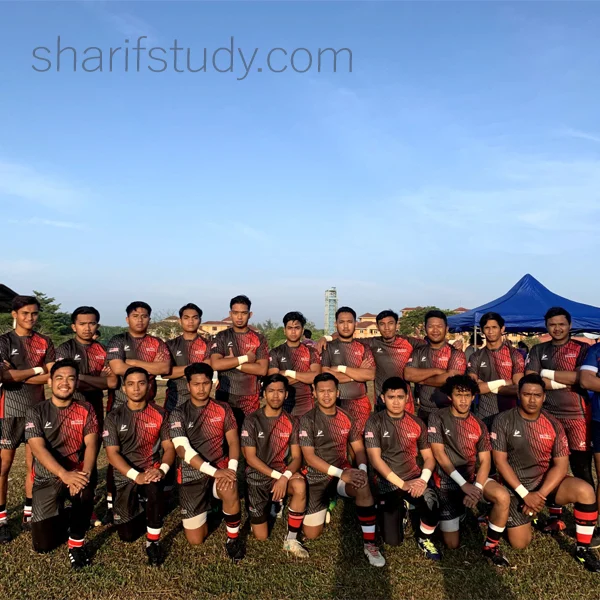

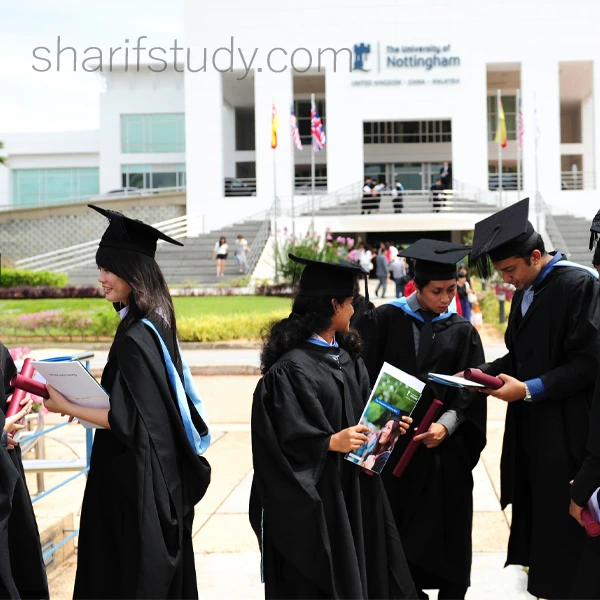




I always love coming back to this peaceful and lovely university location.
I have a lot of recollections from my time spent studying here.
University Putra Malaysia will always have a place in my heart.